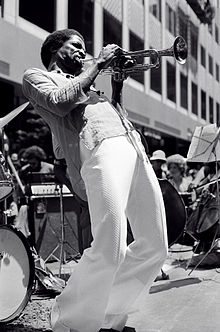Svengali (album)
| Svengali | ||||
|---|---|---|---|---|
| Live album by Gil Evans | ||||
|
Publication |
||||
| Label (s) | Atlantic Records | |||
|
Format (s) |
CD, LP |
|||
|
Title (number) |
6th |
|||
|
running time |
(CD) |
|||
| occupation |
Producer = Kenneth Noland , Gil Evans |
|||
|
Studio (s) |
New York City |
|||
|
||||
Svengali is a jazz album by Gil Evans . It was recorded in two recording sessions on May 30th and June 3rd, 1973, released on Atlantic Records , and re-released on CD on ACT Records .
The title of the album
Svengali is an anagram of the band leader's name; it was created by his friend and colleague Gerry Mulligan and later used to denote long-time companions who have worked with Gil Evans on his numerous projects, such as Miles Davis , Cannonball Adderley , George Adams and Hannibal Marvin Peterson . Apart from that, " Svengali ", especially in English, has the meaning of an artistically decisive man in the background.
The album
"Svengali" was recorded live in New York's Trinity Church , except for the track "Zee Zee", which was recorded on June 3rd in the Philharmonic Hall . The post- Ornette Coleman and Eric Dolphy musicians, who were to determine the sound of the orchestra in the 1970s, such as Billy Harper on the tenor saxophone, the tuba player Howard Johnson , who also plays the baritone saxophone and flugelhorn, as well as were heard here for the first time in 1973 the trumpeter Hannibal Marvin Peterson. Another element that determined the music of "Svengali" was Evans' interest in electronic sounds; In several tracks on the album, the band leader played the electric piano, the bassist Herb Bushler played bass guitar; Evans had also brought keyboardist David Horowitz into the band to add synthetic-electronic timbres.
"Zee Zee" (already recorded in the previous album) is a feature for the "fiery" Peterson, another track on the album is Billy Harper's composition "Cry of Hunger" after Cook and Morton, in which he plays a longer solo. The title was then reassembled - in a process similar to that which Teo Macero did with Miles Davis albums like Bitches Brew - Evans was more or less an ex-post-facto composer , according to Cook and Morton in the Penguin Guide to Jazz .
Impact history
The album is considered "perhaps the most definitive record by the Gil Evans Orchestra" of the 1970s, according to Evans biographer Raymond Horricks in 1983. Evans biographer Stephanie Stein Crease calls it "one of the best examples of Gil Evans' band in the 1970s . “It got rave reviews and was nominated for a Grammy . Down Beat magazine awarded five stars.
Richard Cook and Brian Morton award the album with the second highest grade of three and a half stars in their Penguin Guide to Jazz on CD . Ian Carr is one of the band leader's most notable albums in Jazz Rough Guide “Svengali”, especially because of Billy Harper's introductory solo in the title “Thoroughbred”, which he considers “a small masterpiece”. However, he expresses reservations about the sound of the album, especially with the freer collective improvisations.
Edition history
The album was released in 1973 as a long-playing record on Atlantic Records , but was hardly promoted by the label, was then out of print for a long time and was then released as a compact disc on the ACT label in the 1990s.
Track list
- Thoroughbred
- Blues in orbit
- Eleven
- Cry of hunger
- Summertime
- Zee Zee
literature
- Ian Carr , Digby Fairweather , Brian Priestley : Rough Guide Jazz. The ultimate guide to jazz. 1800 bands and artists from the beginning until today. 2nd, expanded and updated edition. Metzler, Stuttgart / Weimar 2004, ISBN 3-476-01892-X .
- Richard Cook , Brian Morton : The Penguin Guide to Jazz on CD . 6th edition. Penguin, London 2002, ISBN 0-14-051521-6 .
- Raymond Horricks: Svengali, or the orchestra called Gil Evans. Hippocrene books, Tunbridge, Wells, Spellmont 1984, ISBN 0-88254-909-X .
- Stephanie Stein Crease: Gil Evans: Out of the Cool - His life and music. 2002, Chicago, A Cappella Books / Chicago Review Press. ISBN 978-1-55652-493-6 .
